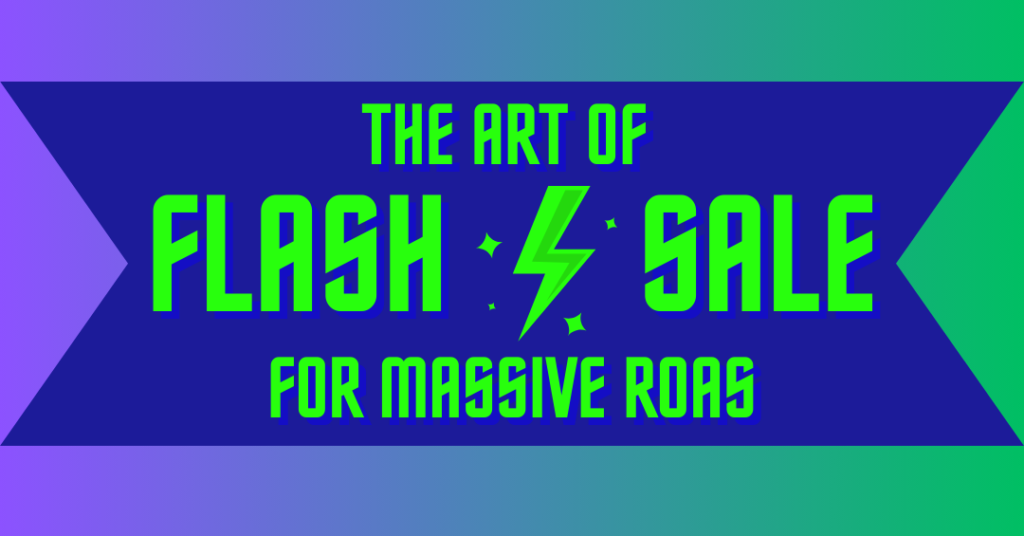Hey Everyone,
This edition is tailor-made for ecommerce owners struggling to achieve a ROAS of 12+ through sales. Believe me, using flash sales is one of the most straightforward strategies to attain double-digit ROAS—when executed correctly.
So, if you’re thinking of launching any kind of sale soon, then this email is just for you.
Breaking Down the Flash Sale Strategy
We’ll dive into this strategy, segmenting it into five primary parts:
-
- Offer
- Ads
- Pre-launch
- Audience
- Launch
- Optimization
1. Offer
The essence of a flash sale lies in the offer:
-
- Play on the FOMO (Fear Of Missing Out). Ensure ad copies resonate with regret, urgency, and limited time.
-
- Focus intensely on the price drop. Make sure you’re wholly confident about the sale’s value proposition
2. Ads
Making ads simple yet effective is the key:
-
- Pause all non-sale-related ads during the flash sale.
-
- Prioritize ads that emphasize the sale, pushing back testimonial-driven or benefit-driven ones.
Elements to include:
-
- Price reductions
- Percentage savings
- Red strikethroughs on original prices
- Count-down timers
- Sale ends at midnight” type alerts
- A frame highlighting “flash sale” on all catalogue ads
3. Pre-launch Strategy
Here’s where it all comes together:
The pre-launch phase is akin to an awareness drive. Warm up your audience with diverse ads, such as case studies, testimonials, and those highlighting benefits a few days (ideally 5 days) before the sale.
Key strategies:
- Drive visitors to your site to acquaint them with the original prices.
- Target TOFU (Top Of Funnel) audiences, such as Engaged Shoppers for Apparel brands or those with specific interests depending upon the niche and industry (refer to the audience section from my book for more ideas).
- Anticipate a short-term lower ROAS. For instance, we had a ROAS of 4, with a target of 5.5, but this pays off during the sale.
- Engage traffic with ads optimized for scroll depth or time spent or just landing page view, whatever works best. This draws significant traffic volumes to the site.
4. Audience Selection
Perfecting your audience targeting:
Target those familiar with your prices or those showing high interest in your products.
Funnel strategy:
1. TOFU (Top Of the Funnel):
-
- Focus on interests closely related to your products.
-
- Allocate only 20% of your budget, adjusting based on sale duration.
2. MOFU (Middle Of Funnel):
-
- Target lookalikes of those who’ve shown interest, be it purchasers, engaged video viewers, or those initiating checkouts.
-
- Allocate 50% of your budget.
3. BOFU (Bottom Of Funnel):
-
- Keep it straightforward: target everyone who has interacted with your properties.
-
- Allocate the remaining 30% of your budget.
Ensure your focus remains on capitalizing on the existing audience, rather than exploring new ones. By honing this strategy, we saw a 239% increase in the Average Order Value per customer.
If you are struggling at finding these audiences, consider going through the book again.
5. Launch
Launching is straightforward:
Just hit the “enable” button. It’s that simple!
6. Optimization
Your primary focus should be here, and the approach differs based on the product’s value.
You’re either selling a low-ticket item or a high-ticket item, and the optimization strategies will differ for each.
A. Low-Ticket Items:
Let’s first address low-ticket items:
Optimizing these is straightforward. If the campaigns yield a good ROAS, scale them. If they don’t, pause them.
For those campaigns that gave you a low ROAS, ask yourself the following:
Which of these five factors was the issue?
1. Thumbstop ratio/hook rate (percentage of 3-sec video views/impressions)
2. Hold rate (percentage of thruplays to 3-sec video views)
3. CPM
4. CTR
5. CPC
Identify which metric was problematic and work on improving it. Stay tuned to our future newsletters, where I’ll provide specific tips for enhancing each of these metrics.
For the winning creatives, generate hundreds of variations and run them across the same or different audiences to further improve results. Check out the TikTok ads library for inspiration on creating more iterations and refining them.
B. High-Ticket Items:
Now, let’s talk about high-ticket items:
Here, it might take several hours or even a couple of days to record the first order. During this period, you should focus exclusively on these metrics:
1. Thumbstop ratio/hook rate (percentage of 3-sec video views/impressions)
2. Hold rate (percentage of thruplays to 3-sec video views)
3. CPM
4. CTR
5. CPC
Based on the performance of these metrics, make informed decisions early on. Once purchases begin to roll in, you can shift your focus to your primary metrics. Until then, the goal should be to achieve quality, affordable traffic.”
And that’s the recipe for sailing smoothly through a flash sale and clinching a double-digit ROAS. The secret sauce is now yours. Stay tuned for future newsletters, where we’ll delve deeper into enhancing individual metrics.
